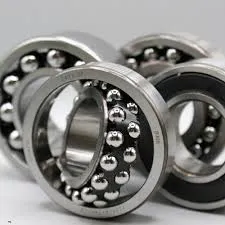
10 月 . 05, 2024 18:39 Back to list
tapered roller bearing components
Understanding Tapered Roller Bearing Components
Tapered roller bearings are an essential component in many mechanical systems, offering unique advantages in terms of load handling and efficiency. These bearings are designed to accommodate both radial and axial loads, making them versatile for various applications ranging from automotive to industrial machinery. Understanding the components of tapered roller bearings can help in appreciating their functionality and the engineering principles behind their design.
Main Components of Tapered Roller Bearings
1. Inner Race (Cone) The inner race, often referred to as the cone, is a part that fits onto the shaft. It has a conical shape that allows for the tapered roller bearings to make contact at a specific angle. The inner race is crucial as it provides a surface for the rollers to operate against and helps in distributing the loads.
2. Outer Race (Cup) The outer race, or cup, serves as the stationary component of the bearing. Like the inner race, it has a corresponding conical shape. The outer race is designed to house the tapered rollers and maintain their alignment. Its sturdy construction withstands external loads and environmental factors.
3. Tapered Rollers The tapered rollers are the heart of the bearing's design. Their conical shape enables efficient load distribution, allowing for higher load capacities and better performance under stress. The tapered configuration helps align the rollers with the races, reducing friction and wear and ensuring smooth operation. These rollers are typically made from high-strength steel or other durable materials to enhance resistance to fatigue and wear.
4. Cage (Separator) The cage or separator is a component that keeps the tapered rollers spaced evenly within the races. Its primary purpose is to prevent the rollers from coming into contact with each other, which could lead to premature wear and failure. The cage plays a crucial role in maintaining the structural integrity of the bearing and ensuring it operates smoothly.
tapered roller bearing components

5. Seals and Shields Many tapered roller bearings are equipped with seals or shields. These components help protect the internal aspects of the bearing from contamination by dust, dirt, and moisture. Seals are designed to retain lubrication, while shields provide a barrier without friction. Proper sealing is vital for extending the lifespan of the bearing and maintaining its performance in demanding environments.
Applications of Tapered Roller Bearings
Tapered roller bearings are widely used across various industries. In the automotive sector, they are found in wheel hubs, transmissions, and differentials, where they support weight while allowing for smooth and efficient movement. In industrial applications, these bearings are essential in equipment like conveyor systems, agricultural machinery, and construction machinery.
Their ability to handle both radial and axial loads makes them suitable for high-speed applications. Additionally, their design allows for easy assembly and adjustment, making maintenance simpler.
Conclusion
In summary, tapered roller bearings consist of integral components that work in harmony to provide reliable and efficient performance. The inner and outer races, tapered rollers, cages, and seals all contribute to the strength and durability of these bearings. Their widespread use across various applications highlights their importance in modern engineering. Understanding the components and functionalities of tapered roller bearings can help engineers and technicians make informed choices for optimal performance in their specific applications.
Latest news
-
Unlocking Efficiency with Spherical Roller Bearings
NewsOct.29,2024
-
The Ultimate Guide to Thrust Ball Bearings
NewsOct.29,2024
-
The Power of Thrust Roller Bearings: Engineered for Excellence
NewsOct.29,2024
-
The Power of Deep Groove Ball Bearings for Your Application Needs!
NewsOct.29,2024
-
The Power and Performance of Cylindrical Roller Bearings
NewsOct.29,2024
-
High-Quality Ball Bearing Manufacturing Machines
NewsOct.29,2024
